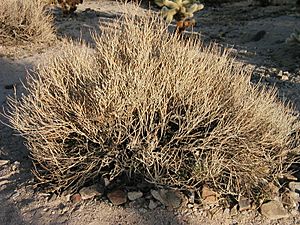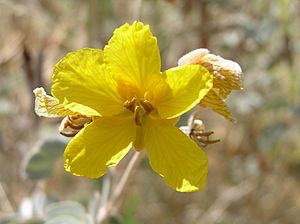Desert senna facts for kids
Quick facts for kids Desert senna |
|
|---|---|
 |
|
| Desert Senna plant in the Mojave Desert portion of Joshua Tree National Park, California | |
| Conservation status | |
| Scientific classification | |
| Synonyms | |
|
Cassia covesii A.Gray |

The Desert Senna (scientific name: Senna covesii) is a cool plant that grows in the desert! It's also known by other names like Coues' senna, rattleweed, or rattlebox. This plant is a type of perennial subshrub. This means it's a small, woody plant that lives for more than two years. It belongs to the Fabaceae family, which is also known as the pea or bean family.
You can find the Desert Senna in the Mojave Desert and Sonoran Desert. These deserts are in places like southeastern California, southern Nevada, and Arizona in the United States. You can also find it in northern Baja California, Mexico. The plant's scientific name, covesii, was chosen to honor a bird expert named Elliott Coues.
About the Desert Senna
Where It Grows
Desert Senna loves to grow in flat desert areas. It also likes sandy places where water flows, called washes. You can find it at heights between 500 and 600 meters (about 1,640 to 1,970 feet) above sea level. It's super common in Joshua Tree National Park!
What It Looks Like
This plant usually grows to be about 30 to 60 centimeters (1 to 2 feet) tall. For most of the year, it doesn't have many leaves.
- Leaves: When it does have leaves, they are about 3 to 7 centimeters (1 to 3 inches) long. Each leaf has two or three pairs of smaller leaflets. These leaflets are shaped like ovals and are about 1 to 2.5 centimeters (0.4 to 1 inch) long.
- Flowers: The flowers are bright yellow. They have five round petals, and each petal is about 12 millimeters (half an inch) long.
Why It's Important
The Desert Senna is a tough plant that helps the desert ecosystem.
- Landscaping: People sometimes plant Desert Senna in gardens. It's also used in programs that plant wildflowers along roadsides.
- Insect Friends: Its bright yellow flowers attract different kinds of bees. These include carpenter bees and bumblebees, which help pollinate the plant.
- Butterfly Food: Sulphur butterflies also use the Desert Senna. They lay their eggs on the plant, and when the eggs hatch, the caterpillars eat the leaves. This makes the plant an important food source for these butterflies.


